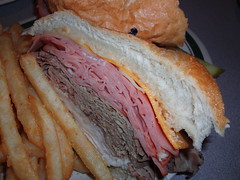Time for an update on my quest for the perfect cardamom bread.
When my wife's grandmother died more than a dozen years ago, she and her mother divided up the numerous cookbooks and recipes in Grannie's kitchen. Born on an island in Sweden early in the last century, Grannie as a teenager braved a solo journey to America, landing on Ellis Island in the early 1920s. Her cooking, especially her baking, remains legendary in my wife's family.
So when I decided some years ago to bake a cardamom bread, I began by leafing through Grannie's collection of yellowing church cookbooks and
Vasa (a Swedish self help organization) recipe collections. To my surprise, the recipes I tried yielded disappointing results. The breads came out too dry and lacking strong cardamom flavor. Perhaps with cardamom so expensive, people had to skimp.
Bottom line: Tradition failed.
In spite of my lackluster results, I could taste the potential. The breads I made were
mediocre, but I could sense that the right combination of milk, butter, sugar, yeast and cardamom would produce a truly tasty and deeply satisfying bread.
I turned, like any red-blooded American of the 21st century, to the Internet. I found pages and pages of results. I soon learned that Cardamom recipes are to Swedes what marinara recipes are to Italians: Everyone has their own variation. Some were outrageously rich calling for multiple eggs and two sticks of butter. Too much, I thought. I don't want to bake a bread that sends diners running to the emergency room for an angioplasty.
Trolling, I found a promising
recipe on blog written by a Mike Swanson. Swedish name, so that's got to be a good sign, I figured, even if his site calls him a "technical evangelist," whatever that means. Recipes are non-sectarian, I told myself. Let's give a shot.
The instructions, to my surprise, did not call for kneading. That didn't make sense to me, so I kneaded. The result was somewhat disappointing. The bread was better than others I'd made, but it still came out too dry and too dense.
So I tried it a second time, this time actually following the instructions (what a concept!) and not kneading the dough. The result was excellent, a rich, airy bread suffused with cardamom flavor. I added an egg wash and pearl sugar sprinkled, giving the finished product a deep brown color and little explosions of sweetness as it's eaten.

Having now made the recipe several times, I can say it's a good one, although it needs twice as long in the oven as the instructions say.
Here it is with the added bake time:
3/4 cup of whole milk
1/4 cup (one stick) butter
1 egg
1/3 cup sugar
1/2 teaspoon salt
3 cups flour
2 teaspoons
2 teaspoons ground cardamom
Microwave the butter and the milk until the butter melts. Mix with remaining ingredients in bowl. Dough should be soft and glistening. Divide into three long strips, cover with cloth and allow to rest for 10 minutes. Braid into a loaf, top with egg wash and pearl sugar and bake for about 40 minutes. Cool on rack.




